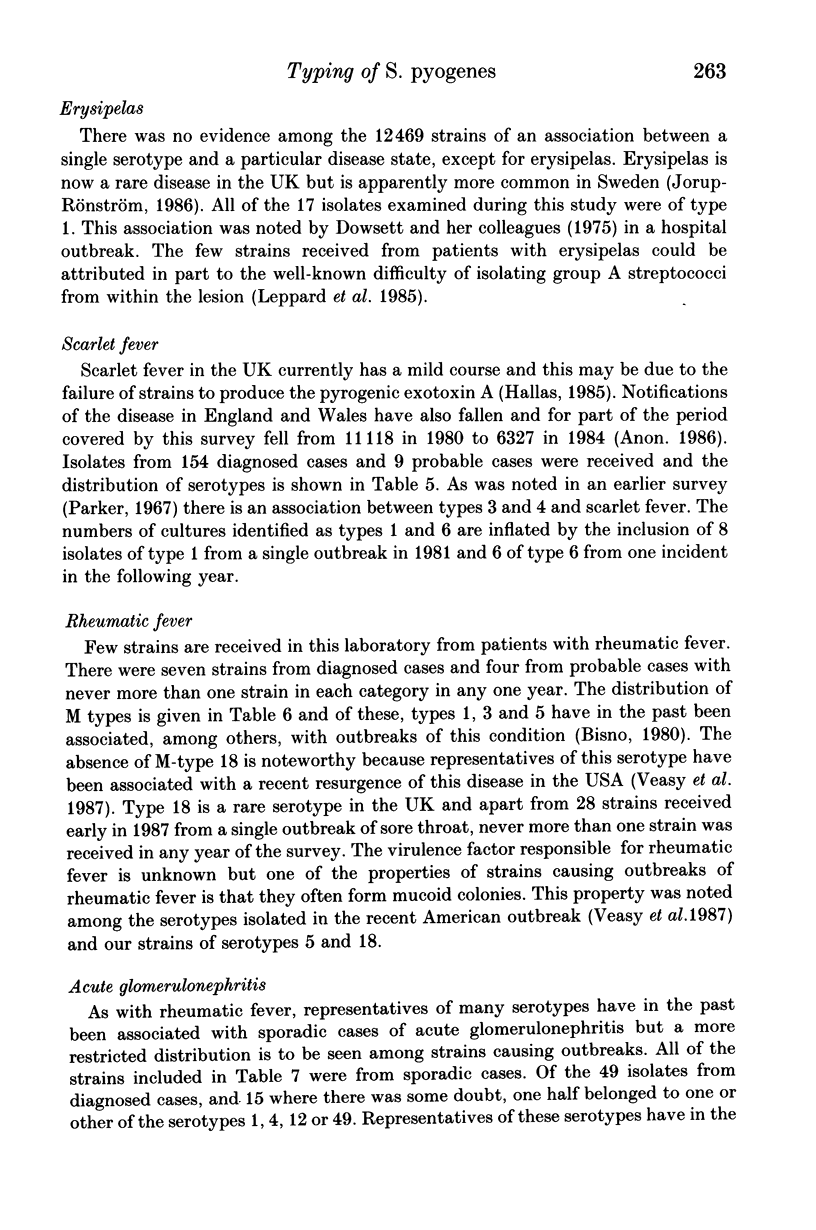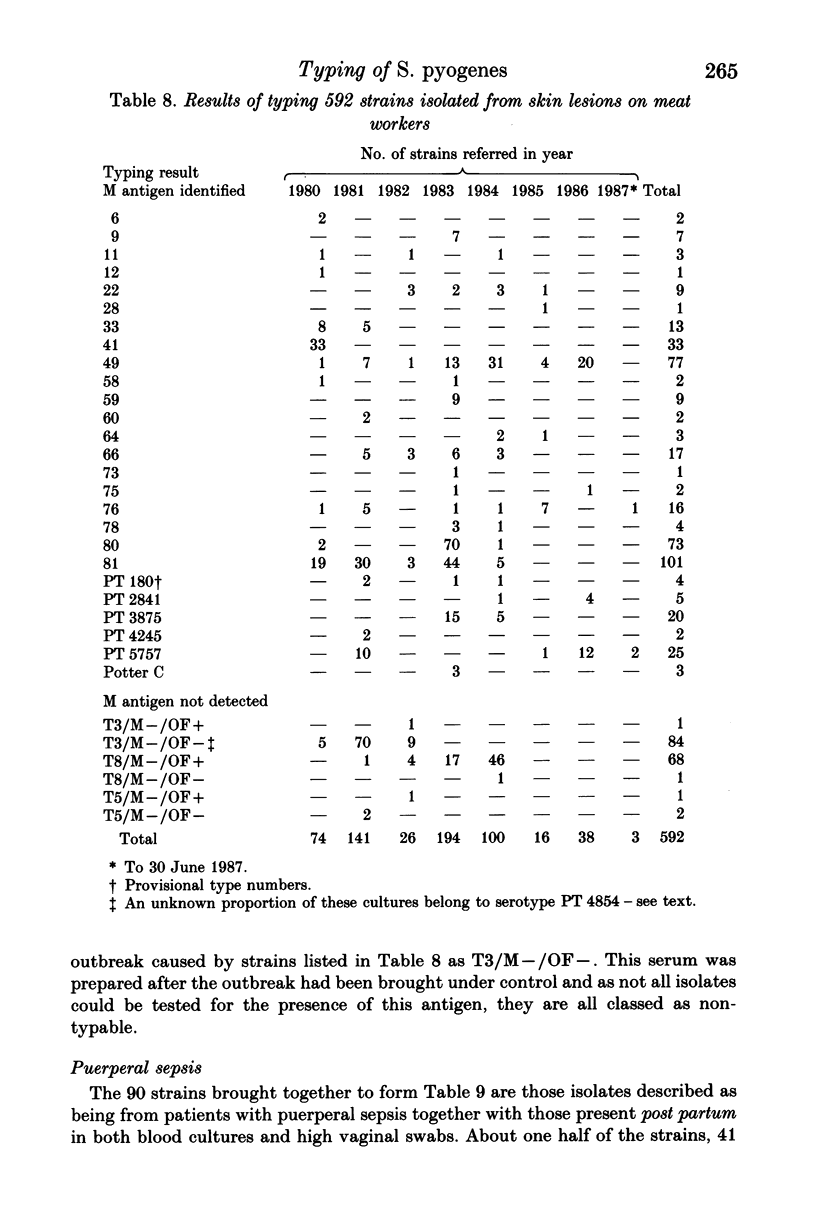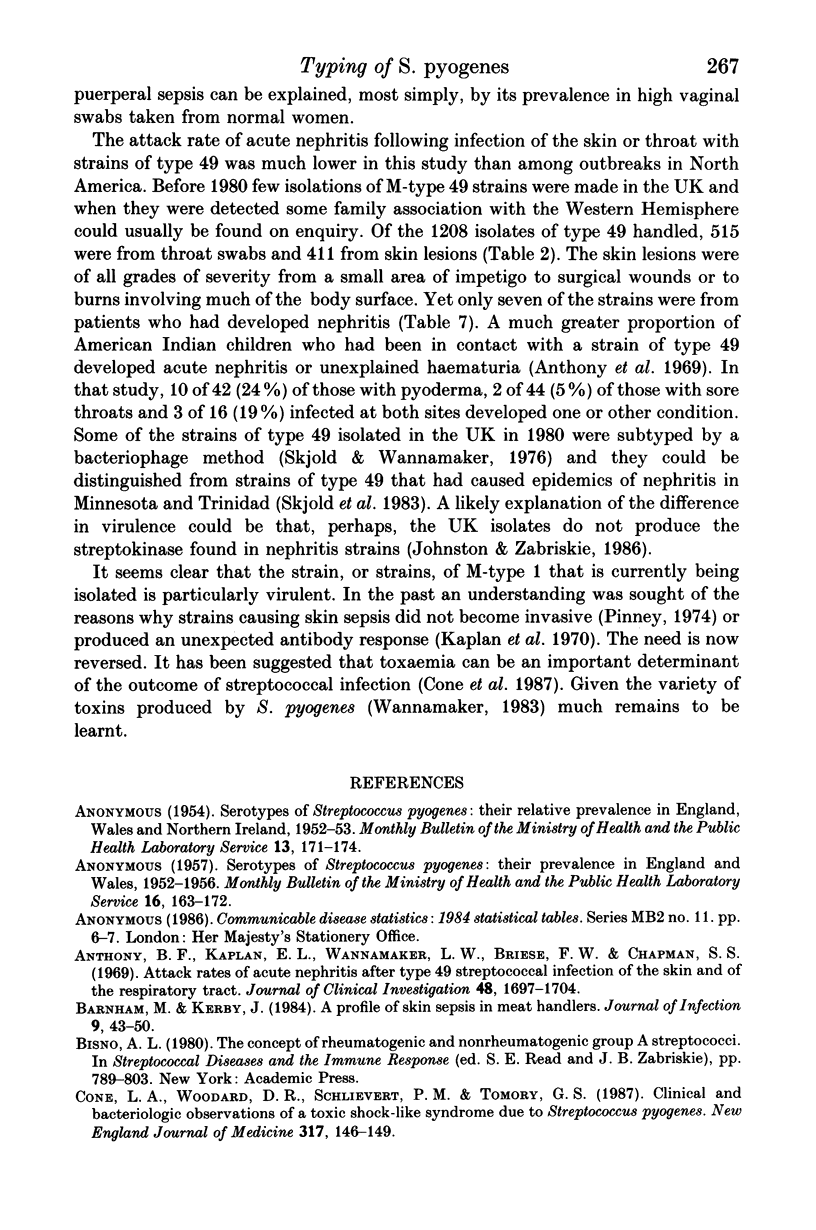Abstract
The distribution of T- and M-protein antigens was determined in 12,469 cultures of Streptococcus pyogenes sent to a reference laboratory. Of these 7232 (58%) were isolates from hospital patients, 249 (2%) from hospital staff and 4988 (40%) from the community. The survey extended from January 1980 to June 1987. During this time the numbers of isolates of M-types 6, 49 and 81 rose then fell, being replaced by types 1, 3 and 28. The proportion of isolates of M-types 4 and 12 remained constant. Few strains were received from cases of nephritis or rheumatic fever but there has been an increase in the number of strains from serious infections and deaths. Forty-four of the 55 (80%) strains received since 1985 from fatal infections have belonged to M-type 1. All other strains, bar two, received from fatal infections in those years belonged to M-type 3. Representatives of M-type 1 were also associated with erysipelas. Types 3 and 4 predominated among the isolates from scarlet fever, types 1, 4, 12 and 49 from nephritis, types 49 and 81 from skin infections in meat workers and type 28 in cases of puerperal sepsis. The M-typability rate was 97% but new M antigens await definition among strains causing pyoderma.
Full text
PDF












Selected References
These references are in PubMed. This may not be the complete list of references from this article.
- Anthony B. F., Kaplan E. L., Wannamaker L. W., Briese F. W., Chapman S. S. Attack rates of acute nephritis after type 49 streptococcal infection of the skin and of the respiratory tract. J Clin Invest. 1969 Sep;48(9):1697–1704. doi: 10.1172/JCI106135. [DOI] [PMC free article] [PubMed] [Google Scholar]
- Barnham M., Kerby J. A profile of skin sepsis in meat handlers. J Infect. 1984 Jul;9(1):43–50. doi: 10.1016/s0163-4453(84)94472-4. [DOI] [PubMed] [Google Scholar]
- Cone L. A., Woodard D. R., Schlievert P. M., Tomory G. S. Clinical and bacteriologic observations of a toxic shock-like syndrome due to Streptococcus pyogenes. N Engl J Med. 1987 Jul 16;317(3):146–149. doi: 10.1056/NEJM198707163170305. [DOI] [PubMed] [Google Scholar]
- Cruickshank J. G., Hart R. J., George M., Feest T. G. Fatal streptococcal septicaemia. Br Med J (Clin Res Ed) 1981 Jun 13;282(6280):1944–1945. doi: 10.1136/bmj.282.6280.1944. [DOI] [PMC free article] [PubMed] [Google Scholar]
- Dowsett E. G., Herson R. N., Maxted W. R., Widdowson J. P. Outbreak of idiopathic erysipelas in a psychiatric hospital. Br Med J. 1975 Mar 1;1(5956):500–502. doi: 10.1136/bmj.1.5956.500. [DOI] [PMC free article] [PubMed] [Google Scholar]
- Duben J., Jelínková J., Mícková S., Havlícková H., Vojtéchovská H., Beránek M., Rotta J. Nine-year study of streptococcal infections in a sample of the general population. J Hyg Epidemiol Microbiol Immunol. 1978;22(2):162–176. [PubMed] [Google Scholar]
- Efstratiou A. Preparation of Streptococcus pyogenes suspensions for typing by the agglutination method. Med Lab Sci. 1980 Oct;37(4):361–363. [PubMed] [Google Scholar]
- Ferrieri P. Acute post-streptococcal glomerulonephritis and its relationship to the epidemiology of streptococcal infections. Minn Med. 1975 Aug;58(8):598–602. [PubMed] [Google Scholar]
- Ferrieri P., Dajani A. S., Wannamaker L. W., Chapman S. S. Natural history of impetigo. I. Site sequence of acquisition and familial patterns of spread of cutaneous streptococci. J Clin Invest. 1972 Nov;51(11):2851–2862. doi: 10.1172/JCI107108. [DOI] [PMC free article] [PubMed] [Google Scholar]
- Fraser C. A., Ball L. C., Morris C. A., Noah N. D. Serological characterization of group-A streptococci associated with skin sepsis in meat handlers. J Hyg (Lond) 1977 Apr;78(2):283–296. doi: 10.1017/s0022172400056175. [DOI] [PMC free article] [PubMed] [Google Scholar]
- Fraser C. A. Preparation of specific antisera to the opacity factors of group-A streptococci. J Med Microbiol. 1982 May;15(2):153–162. doi: 10.1099/00222615-15-2-153. [DOI] [PubMed] [Google Scholar]
- Guirguis N., Fraser D. W., Facklam R. R., El Kholy A., Wannamaker L. W. Type-specific immunity and pharyngeal acquisition of group A Streptococcus. Am J Epidemiol. 1982 Dec;116(6):933–939. doi: 10.1093/oxfordjournals.aje.a113495. [DOI] [PubMed] [Google Scholar]
- Hallas G. The production of pyrogenic exotoxins by group A streptococci. J Hyg (Lond) 1985 Aug;95(1):47–57. doi: 10.1017/s0022172400062276. [DOI] [PMC free article] [PubMed] [Google Scholar]
- Johnston K. H., Zabriskie J. B. Purification and partial characterization of the nephritis strain-associated protein from Streptococcus pyogenes, group A. J Exp Med. 1986 Mar 1;163(3):697–712. doi: 10.1084/jem.163.3.697. [DOI] [PMC free article] [PubMed] [Google Scholar]
- Jorup-Rönström C. Epidemiological, bacteriological and complicating features of erysipelas. Scand J Infect Dis. 1986;18(6):519–524. doi: 10.3109/00365548609021656. [DOI] [PubMed] [Google Scholar]
- Kaplan E. L., Anthony B. F., Chapman S. S., Ayoub E. M., Wannamaker L. W. The influence of the site of infection on the immune response to group A streptococci. J Clin Invest. 1970 Jul;49(7):1405–1414. doi: 10.1172/JCI106358. [DOI] [PMC free article] [PubMed] [Google Scholar]
- Leppard B. J., Seal D. V., Colman G., Hallas G. The value of bacteriology and serology in the diagnosis of cellulitis and erysipelas. Br J Dermatol. 1985 May;112(5):559–567. doi: 10.1111/j.1365-2133.1985.tb15264.x. [DOI] [PubMed] [Google Scholar]
- Lütticken R., Wendorff U., Lütticken D., Wannamaker L. W. Typisierung von Gruppe A-streptokokken aus dem Raume Köln (Bundesrepublik Deutschland) Zentralbl Bakteriol Orig A. 1977 Feb;237(1):35–43. [PubMed] [Google Scholar]
- MAXTED W. R. The indirect bactericidal test as a means of identifying antibody to the M antigen of Streptococcus pyogenes. Br J Exp Pathol. 1956 Aug;37(4):415–422. [PMC free article] [PubMed] [Google Scholar]
- MITCHELL E. S. Frequency of serotypes of Streptococcus pyogenes in different diseases. J Clin Pathol. 1962 May;15:231–234. doi: 10.1136/jcp.15.3.231. [DOI] [PMC free article] [PubMed] [Google Scholar]
- Mayon-White R. T., Perks E. M. Why type streptococci? The epidemiology of group A streptococci in Oxfordshire 1976-1980. J Hyg (Lond) 1982 Jun;88(3):439–452. doi: 10.1017/s0022172400070303. [DOI] [PMC free article] [PubMed] [Google Scholar]
- Parker M. T. International survey of the distribution of serotypes of Streptococcus pyogenes (group A streptococci). Bull World Health Organ. 1967;37(4):513–527. [PMC free article] [PubMed] [Google Scholar]
- Pranitis P. A., Murray R. H., Kornfeld J. M. Effect of phenol extraction of group A streptococcus on titer and specificity of fluorescent M-typing antisera. J Infect Dis. 1973 Mar;127(3):250–254. doi: 10.1093/infdis/127.3.250. [DOI] [PubMed] [Google Scholar]
- Skjold S. A., Wannamaker L. W., Johnson D. R., Margolis H. S. Type 49 Streptococcus pyogenes: phage subtypes as epidemiological markers in isolates from skin sepsis and acute glomerulonephritis. J Hyg (Lond) 1983 Aug;91(1):71–76. doi: 10.1017/s0022172400060046. [DOI] [PMC free article] [PubMed] [Google Scholar]
- Skjold S. A., Wannamaker L. W. Method for phage typing group A type 49 streptococci. J Clin Microbiol. 1976 Sep;4(3):232–238. doi: 10.1128/jcm.4.3.232-238.1976. [DOI] [PMC free article] [PubMed] [Google Scholar]
- Top F. H., Jr, Wannamaker L. W. The serum opacity reaction of Streptococcus pyogenes: frequency of production of streptococcal lipoproteinase by strains of different serological types and the relationship of M protein production. J Hyg (Lond) 1968 Mar;66(1):49–58. doi: 10.1017/s0022172400040936. [DOI] [PMC free article] [PubMed] [Google Scholar]
- Veasy L. G., Wiedmeier S. E., Orsmond G. S., Ruttenberg H. D., Boucek M. M., Roth S. J., Tait V. F., Thompson J. A., Daly J. A., Kaplan E. L. Resurgence of acute rheumatic fever in the intermountain area of the United States. N Engl J Med. 1987 Feb 19;316(8):421–427. doi: 10.1056/NEJM198702193160801. [DOI] [PubMed] [Google Scholar]
- WILLIAMS R. E. Laboratory diagnosis of streptococcal infections. Bull World Health Organ. 1958;19(1):153–176. [PMC free article] [PubMed] [Google Scholar]
- Wannamaker L. W. Streptococcal toxins. Rev Infect Dis. 1983 Sep-Oct;5 (Suppl 4):S723–S732. doi: 10.1093/clinids/5.supplement_4.s723. [DOI] [PubMed] [Google Scholar]


